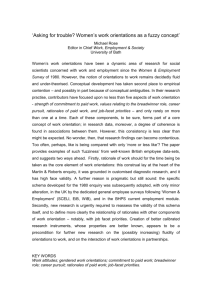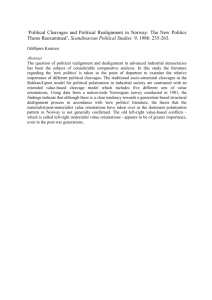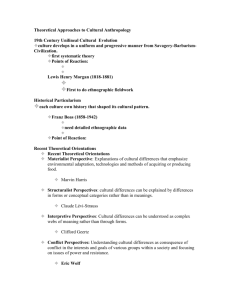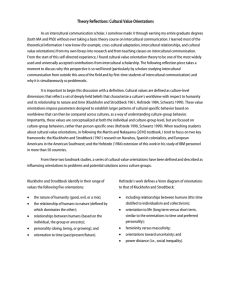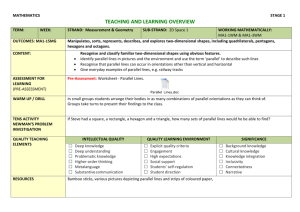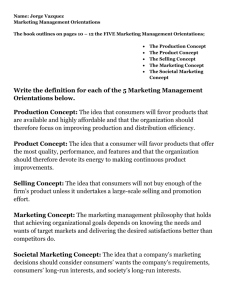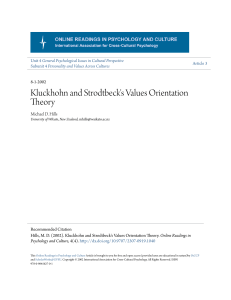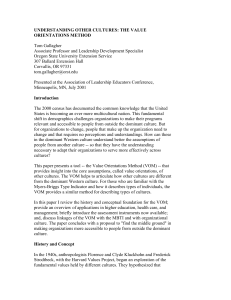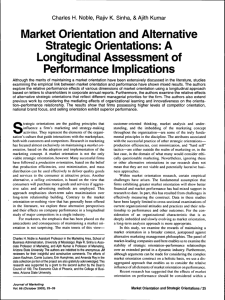The Values Orientations Method
advertisement
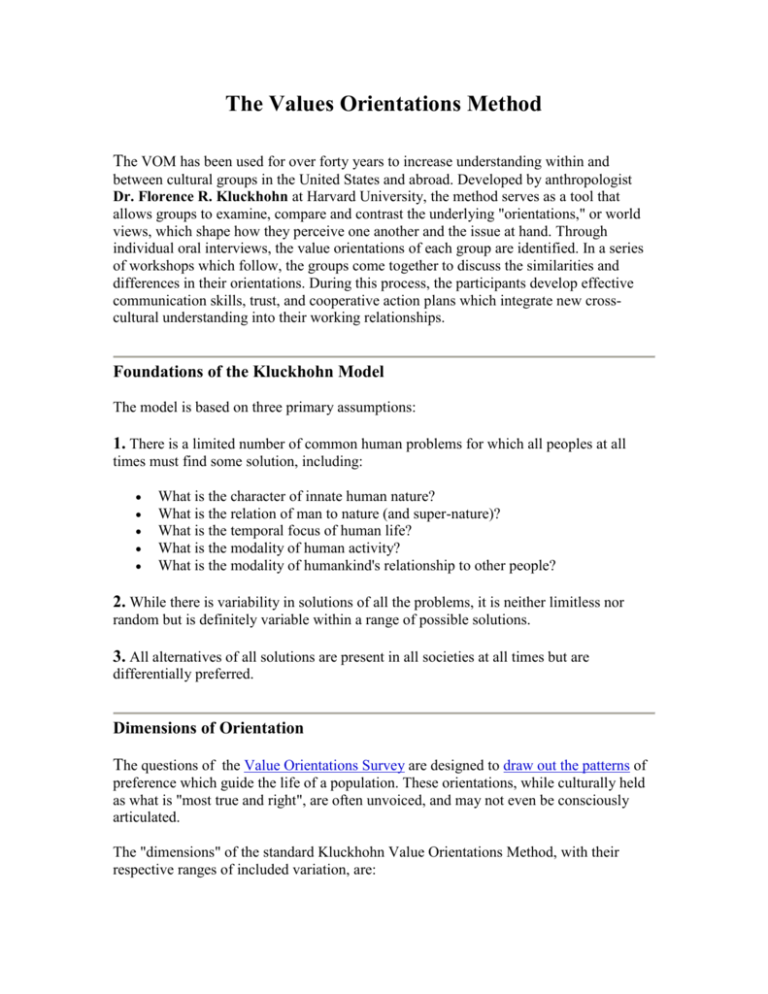
The Values Orientations Method The VOM has been used for over forty years to increase understanding within and between cultural groups in the United States and abroad. Developed by anthropologist Dr. Florence R. Kluckhohn at Harvard University, the method serves as a tool that allows groups to examine, compare and contrast the underlying "orientations," or world views, which shape how they perceive one another and the issue at hand. Through individual oral interviews, the value orientations of each group are identified. In a series of workshops which follow, the groups come together to discuss the similarities and differences in their orientations. During this process, the participants develop effective communication skills, trust, and cooperative action plans which integrate new crosscultural understanding into their working relationships. Foundations of the Kluckhohn Model The model is based on three primary assumptions: 1. There is a limited number of common human problems for which all peoples at all times must find some solution, including: What is the character of innate human nature? What is the relation of man to nature (and super-nature)? What is the temporal focus of human life? What is the modality of human activity? What is the modality of humankind's relationship to other people? 2. While there is variability in solutions of all the problems, it is neither limitless nor random but is definitely variable within a range of possible solutions. 3. All alternatives of all solutions are present in all societies at all times but are differentially preferred. Dimensions of Orientation The questions of the Value Orientations Survey are designed to draw out the patterns of preference which guide the life of a population. These orientations, while culturally held as what is "most true and right", are often unvoiced, and may not even be consciously articulated. The "dimensions" of the standard Kluckhohn Value Orientations Method, with their respective ranges of included variation, are: Person-Nature Orientation Mastery Over: The individual or group can and should exercise total control over the forces of, and in, nature and super-nature Harmony With: The individual or group can and should exercise partial but not total control by living in a balance with the natural forces around them. Subject To: The individual or group cannot and should not exercise control over these forces but, rather, is subject to the higher power of these forces. Sample Question #14. "Belief in Control" (Nature-4) Three people from different areas were talking about the things that control the weather and other conditions. Here is what they each said: A) One said: My people have never controlled the rain, wind, and other natural conditions and probably never will. There have always been good years and bad years. That is the way it is, and if you are wise you will take it as it comes and do the best you can. B) The second said: My people believe that it is our job to find ways to overcome weather and other conditions just as they have overcome so many things. They believe they will one day succeed in doing this and may even overcome drought and floods. C) The third said: My people help conditions and keep thing going by working to keep in touch with all the forces which make the rain, the snow and other conditions. It is when we do the right things—live in the proper way—and keep all that we have—the land, the stock, and the water—in good condition, that all goes along well. Which of these people do you think had the best idea? Which of the people do you think had the second best idea? Which of these three ways best describes how you really are? Which way do you think most other people in your group would say is best? Which way do you think most people in the other group would say is best? Time Orientation Past: The temporal focus is on the past (the time before now), and in preserving and maintaining traditional teachings and beliefs. Present: The temporal focus is on the present (what is now), and in accommodating changes in beliefs and traditions. Future: The temporal focus is on the future (the time to come), planning ahead, and seeking new ways to replace the old. Sample Question #15. "Ceremonial Innovation" (Time-4) Some people in a community like your own saw that the religious ceremonies were changing from what they used to be. C) Some people were really pleased because of the changes in religious ceremonies. They felt that new ways are usually better than old ones, and they like to keep everything— even ceremonies—moving ahead. A) Some people were unhappy because of the change. They felt that religious ceremonies should be kept exactly—in every way—as they had been in the past. B) Some people felt that the old ways for religious ceremonies were best but you just can’t hang on to them. It makes life easier just to accept some changes as they come along. Which of these three felt most nearly what you believe is right? Which of the other two do you think is most right? Which way do you think most other people in your group would say is best? Which way do you think most other people in the other group would say is best? Activity Orientation Doing: The locus of meaning for self-expression is external to the individual, with an emphasis on activity that is valued by both the self and sanctioned by others in the group. Being: The locus of meaning for self-expression is internal to the individual, with an emphasis on activity valued by the self but not necessarily others in the group. Sample Question #16. "Ways of Living" (Activity-3) There were two people talking about how they liked to live. They had different ideas. A) One said: What I care about most is accomplishing things—getting things done just as well or better than other people do them. I like to see results and think they are worth working for. B) The other said: What I care most about is to be left alone to think and act in the ways that best suit the way I really am. If I don’t always get much done but can enjoy life as I go along, that is the best way. Which of these two people do you think has the better way thinking? Which of these two people are you really most like? Which kind of boss do you think most other people in your group would say is best? Which kind of boss do you think most other people in other group would say is best? Human Relations Orientation Collaterality: Emphasis is placed on consensus within the laterally extended group. Lineality: Emphasis is placed on hierarchical principles and deferring to higher authority or authorities within the group. Individualism: Emphasis is placed on the individual or individual families within the group who make decisions independently from the others Sample Question #3. "Well Arrangements" (Relational-1) When a community has to make arrangements for water, such as drilling a well, there are three different ways they can decide to arrange things like location, and who is going to do the work. A) There are some communities where it is mainly the older or recognized leaders of the important families who decide the plans. Everyone usually accepts what they say without much discussion since they are the ones who are used to deciding such things, and are the ones who have had the most experience B) There are some communities where most people in the group have a part in making the plans. Lots of different people talk, but nothing is done until almost everyone comes to agree as to what is best to be done. C) There are some communities where everyone holds to his own opinion, and they decide the matter by vote. They do what the largest number want even though there are still a great many people who disagree and object to the action. Which way do you think it is usually best in such cases? Which way do you think is second best? Which of the three ways do you think you, yourself, would follow? Which way do you think most other people in your group would say is best? Which way do you think most people in the other group would say is best? The standard survey created by Dr. Kluckhohn consisted of these four dimensions, not including "Human Nature." Subsequent surveys, modified by several social scientists, have included this fifth orientation into the survey. The Kluckhohn Center has engaged in several long-term, community building projects which are designed to strengthen inter-cultural relations. The goal of these projects is to bridge the gaps between diverse cultural, ethnic, or economic groups by developing stronger communication, respect, and understanding. Each culture, group of people, and individual has varying value orientations which effect how that person or culture perceives and reacts to their surroundings. Differences in these value orientations sometimes lead to misunderstanding and conflict. The basic issue was articulated by Dr. Florence Kluckhohn over forty years ago: "How is it that people who have lived side by side, sometimes for generations, continue to speak past each other?" Past each other. What does that mean? Do they intend to? Is it based on a conflict of interest? Is it really something we can assess, measure, and understand? And, just because they speak to each other, does that mean they will get along? “Activity” questions A1: Job Choice (a) A2: Job Choice (b) A3: Ways Of Living A4: Care Of Fields A5: Housework A6: Nonworking Time (Survey item #1) (Survey item #2) (Survey item #16) (Survey item #19) (Survey item #22) (Survey item #23) “Nature” questions N1: Livestock Dying N2: Facing Conditions N3: Use Of Fields N4: Belief in Control N5: Length Of Life (Survey item #5) (Survey item #7) (Survey item #11) (Survey item #14) (Survey item #20) “Relational” questions (Survey item #3) (Survey item #8) (Survey item #9) (Survey item #10) R1: Well Arrangements R2: Help In Misfortune R3: Family Work Relations R4: Choice Of A Delegate R5: Wage Work R6: Livestock Inheritance R7: Land Inheritance (Survey item #13) (Survey item #17) (Survey item #18) “Time” questions T1: Child Training T2: Expectations About Change T3: Philosophy Of Life T4: Ceremonial Innovation T5: Water Allocation http://members.aol.com/_ht_a/frkvalues/index.htm (Survey item #4) (Survey item #6) (Survey item #12) (Survey item #15) (Survey item #21)
